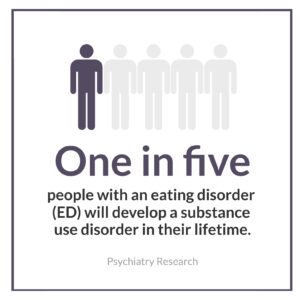By Mandy Parsons
The Cleveland Clinic defines dual diagnosis as a state in which you experience both a mental health disorder and substance use disorder (SUD) simultaneously. This is also referred to as co-occurring disorders or comorbidity.
Research has found that 50% of people with a mental health disorder also suffer from a SUD and vice versa. Among those frequently co-occurring disorders are eating disorders and addiction. Psychiatry Research reports that approximately one in five people with an eating disorder (ED) will develop a substance use disorder in their lifetime.

Disturbingly, Cureus states there is an especially strong association between EDs and SUD in adolescence, citing bulimia nervosa (BN) and alcohol use disorder (AUD) as the most common pairing.
How are these unhealthy behaviors connected? Not only do eating disorders and addiction share risk factors, but they also share similar triggers. It’s important to recognize their differences as well as how the two are linked in order to assess your own risk.
Understanding Drug Addiction and Eating Disorders
Not only do eating disorders and addiction share risk factors, but they also share similar triggers.
Johns Hopkins Medicine explains substance use disorder as “a pattern of using a substance (drug) that causes significant problems or distress.” This may look like increasingly using a substance over longer periods of time; having a preoccupation with getting, using, and recovering from drug use; or taking risks under the influence.
Long-term substance abuse can lead to a host of physical, mental, and social problems, including chronic fatigue, poor hygiene, heart issues, depression and anxiety, absence from school or work, and loss of relationships.
Comparably, eating disorders are negative eating habits that are harmful to your health. EDs often manifest as an obsession with body image, fixation on nutritional content, or use of laxatives, diuretics, and diet pills.
If you have an eating disorder, you may experience a variety of ailments from fainting spells to dental erosions, low blood pressure, and even upper respiratory infections. Mental illness is also prevalent in people with EDs.
Although these two conditions have distinct presentations, there are many parallels as well. Let’s explore the relationship between SUDs and EDs.
The Drug Addiction and Eating Disorders Link
It’s logical that substance abuse and eating disorders overlap, given their age of onset as well as common biological, psychological, and social risk factors. Teens and young adults are especially prone to experiencing co-occurring disorders.
According to Cureus, eating disorders primarily affect young women who are mainly diagnosed in adolescence and early adulthood, Substance use disorders also typically start in adolescence and young adulthood.
Additionally, persons susceptible to eating disorders or substance abuse share characteristics that put them at a higher risk for developing these illnesses. Psychiatry Research explains that ED and SUD diagnoses have many of the same determinants, including:
- Depression and anxiety
- Suicidality
- Childhood trauma
- Brain chemistry
- Family history of psychiatric illness
- Compulsive behavior
- Perfectionist qualities
- Family and cultural influences
- Trouble regulating emotions
The triggers for both behaviors are similar too. Substance abuse and eating disorders are an attempt to cope with uncomfortable emotions like shame, loneliness, fear, stress, grief, or anger.
Those with eating disorders may use drugs and alcohol to manage negative feelings. Psychiatry says bulimic patients often drink alcohol excessively to avoid thinking about food, cope with their ED challenges, or suppress their appetite.
Similarly, individuals who abuse substances often abuse food, too, for comfort. Someone with AUD may frequently participate in binge-eating behaviors. This is especially true during treatment and recovery when a patient may substitute one problematic behavior for another.
Treatment Options and Support
Early intervention, treatment, and support are critical to a successful recovery from an eating disorder and co-occurring disorders.
For example, the Collegiate Recovery Community (CRC) eating disorder program at Texas Tech University is one of the first communities of its kind to recognize the need for eating disorder support services among students who are struggling with drug or alcohol addiction.
Dual diagnosis treatment centers focus on helping you to identify and understand how your disorders influence one other. They incorporate various therapeutic approaches to treat them separately and together.
Integrated therapy can encompass anything from behavioral therapy to prescribed medication to trauma-informed care. Group support systems comprising family, friends, and peers additionally play a key role in the healing process.
Give Us a Call
At The Meadows Ranch, we aim to identify and treat any mental health issues you may be struggling with in addition to your eating disorder. Our treatment is whole-person-oriented, individualized, and comprehensive in our approach to mental health. Recovery from one disorder without recovery from others is not true recovery and can lead to relapse in the future. So treating all disorders at once provides a higher likelihood of long-term success.
If you are suffering from an eating disorder with or without addiction or other mental health issues, you deserve healing. At The Meadows Ranch, our knowledgeable and caring staff are ready to help you embark on a journey toward long-term healing. To learn more about how we can help you or your loved one, contact us today.

